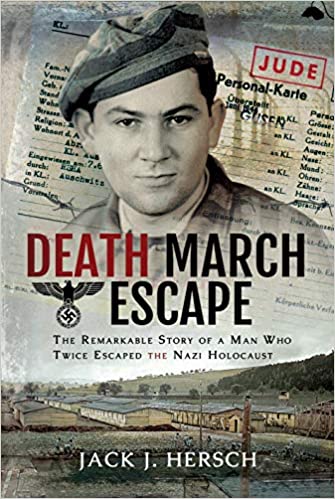Death March Escape by Jack J. Hersch
Editor’s note: This story was originally published on January 24, 2019. BookTrib is running it again for International Holocaust Remembrance Day. “Dragging himself weakly, he made it to the side of the road. To go to the side of the road meant death. It was a firm rule of the ‘transports.’ He sat down on a boulder, took off his wooden shoes, and waited to die. An SS trooper guarding the march spotted him sitting, and walked towards him, his pistol ready.” “‘We looked right at each other. I looked right into his eyes. Then he looked at my shoes on the ground, then back to me, and I don’t know what happened. He kept walking! He walked right past me!'” That’s one of the incredible anecdotes from a book overflowing with them. Given the story, you’d expect nothing less. Death March Escape (Frontline Books) by Jack J. Hersch is the true, unimaginable story of his father, David Arieh Hersch, who twice escaped death marches during the Nazi Holocaust. It’s the story of David’s countless ailments, emotional torture, other unexplainable horrors and remarkable escapes from the concentration camps. But it also is the tale of how Jack, having long heard his father’s story of survival and escape, came upon a photograph of his father on the Mauthausen Concentration Camp Memorial’s website — launching him into an all-consuming mission to learn the secrets his father never told him. The infamous death marches occurred when the Third Reich was nearing defeat. As Allied forces made their way toward the camps, Nazi soldiers marched hundreds of thousands of prisoners to camps further away. Basically, these were forced evacuations that caused prisoners to walk hundreds of miles. Many died from exhaustion (or other ailments) while walking or if they sat down to rest they were shot. It was David’s transport in 1945 to KZ Gunskirchen, near an Austrian town, that provided the circumstances of his first escape. As Jack further writes of the anecdote above, “The storm trooper had holstered his pistol and was walking on. My father was absolutely incredulous. It was supposed to be over for him. He was supposed to be dead. There were never any exceptions to the ironclad rule of the march.” “The shock of not being dead gave him a jolt that sprang him back onto his feet…..With his renewed energy, he pushed himself to move again.” To begin this epic tale, Jack explains his own beginning. On a warm Los Angeles morning in 2007, Jack’s cousin called from Israel. She had seen a photograph of David on the Mauthausen website. Thus began Jack’s exploration into the depth of David’s stay at the camps. Chronologically following his personal trip to Austria to see the camps and also telling his father’s story as it was relayed to him, two perspectives are shared on one family’s dark past. Jack’s learning process on many events that were shielded from him provides a powerful theme of self-discovery. For further clarity, Jack aids readers in their historical understanding by giving brief synopses to know the location of the army is that eventually liberates David and its progress toward David. At the outset of a second death march, just several days after the first, Jack captures his father’s matter-of-fact tone to describe the dilemma when sitting down with some other prisoners. The SS troopers advised that the group could continue on the march, go back to the camp, or be shot. “My father said this as if he was on a game show and had been given a choice of three doors to select – just pick one. It amazed me how calmly he ticked off these live-or-die options.” Jack’s story gives sharp focus to the horrific conditions of the concentration camps. The anecdotes detail the extremes to which prisoners went to survive. At one point, David overhears other prisoners as they swap real food for smooth pebbles. The pebbles were preferable because they could make a person feel fuller for longer. It seemed like solid logic for a while, until the prisoners discovered that the pebbles also blocked the intestines and caused some of them to die gruesome deaths. David was lucky enough to pass the pebbles and to never attempt the trick again. While in the camp infirmary, David learned how to successfully steal deceased prisoners’ food without the knowledge of the guards. Cunningly, he would pretend someone who died overnight was still awake by speaking to them so the guard would hand out the breakfast that David could then eat. Another survival technique was searching a prisoner’s death bed for hidden stores of food before the body was removed. As we approach International Holocaust Remembrance Day later this month, Death March Escape is a story of one man’s remarkable plight, offering a unique inside, outside and historic look at the Nazi Holocaust. Death March Escape is available for purchase. Learn more about Jack on his Author Profile page.Want more BookTrib? Sign up NOW for news and giveaways!

Genre: Nonfiction
Author: Jack J. Hersch
Publisher: Frontline Books
ISBN: 9781526740230






I love this format.
Death March Escape caught my interest and made me look further into Book Trib.
This is a great vehicle for those read occasionally or often.
Great website .
Marshall Moss